Sony Alpha A77 Review
Sony Alpha A77
With its 12fps burst speed and 24.3MP sensor the Sony A77 packs quite a punch.
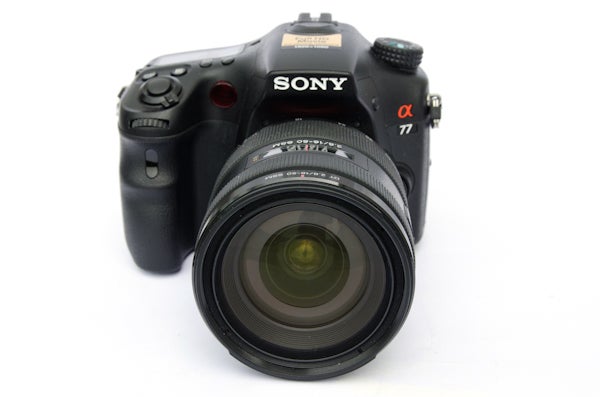
Verdict
Pros
- Fastest continuous shooting speed in its class
- Excellent image quality
- Generous range of HD movie recording options
- Lots of useful features and customisation options
- EVF is the best we've yet seen
Cons
- EVF still not as good as a traditional viewfinder
Key Specifications
- Review Price: £1400.00
- 24.3MP APS-C Sony Exmor CMOS sensor
- 12fps continuous shooting speed
- ISO 50 - 16000
- 1080/25/50p Full HD movie recording
- 3in, 921k-dot vari-angle LCD / 2.36m-dot EVF
- Built-in GPS functionality
Launched earlier this year, the Sony A77 is the flagship model in Sony’s Single Lens Translucent (SLT) range. SLT cameras differ from traditional DSLRs in that the internal mirror is fixed in place rather than being hinged. The primary benefit of this approach is speed – in a regular DSLR the mirror has to swing open to allow light through to the sensor which results in a slight delay between frames, whereas in an SLT camera the translucent mirror allows some light to pass through to the sensor while also bouncing some up into the roof of the camera. 
Not only does this mean that SLT cameras like the A77 can benefit from the faster phase detection technology used in regular DSLRs, but because the mirror doesn’t need to move continuous shooting speed can be increased. To this end the A77 is able to shoot at a staggering 12fps at full resolution, which makes it the fastest prosumer camera of its type. Indeed, the A77 is even faster than the Nikon D4 (10fps) and only slightly bettered by the Canon EOS 1Dx’s 14fps (when used in High-Speed mode). And at around £5300 each, both of those pro-grade DSLRs will set you back nearly four times as much as the A77.
Of course speed isn’t everything and the A77 has plenty else going for it too. Other notable features include built-in GPS, automatic HDR capture, Sony’s excellent ultra-wideangle Sweep Panorama technology, a vari-angle 3in/921k-dot rear LCD monitor, a class-leading 2.36m-dot electronic viewfinder, 1080/50p Full HD movie recording with Quick AF, a built-in 1.4x/2x Smart Teleconverter digital zoom that records images at 12MP/6MP respectively, and Sony’s own SteadyShot image stabilisation technology. Last but not least, the A77 also offers a generous range of image-enhancing features including a number of Creative Style processing options, Picture Effect digital filters along with a dynamic range optimisation tool. Safe to say that the A77 is not lacking in features then.
The A77 is built around an APS-C sized (23.5 x 15.6mm) Sony Exmor CMOS sensor that delivers 24.3MP of effective resolution – currently the highest in its class. Able to record JPEG and lossless Raw image files, maximum output at the full 24.3MP is 6000 x 4000 pixels. This enables the A77 to deliver lots of fine detail, which means it can easily be used to make poster-sized A1 prints with, while also giving you the flexibility to aggressively crop your images post-capture should you need to. If you don’t require quite so much resolution (for example, when shooting purely for web use) then it’s also possible to shoot at either 12MP (medium) or 6MP (small) in the default 3:2 aspect. In addition, it’s also possible to shoot in 16:9 at a choice of 20MP, 10MP or 5.1MP. There’s no provision to shoot in 4:3 or 1:1 though.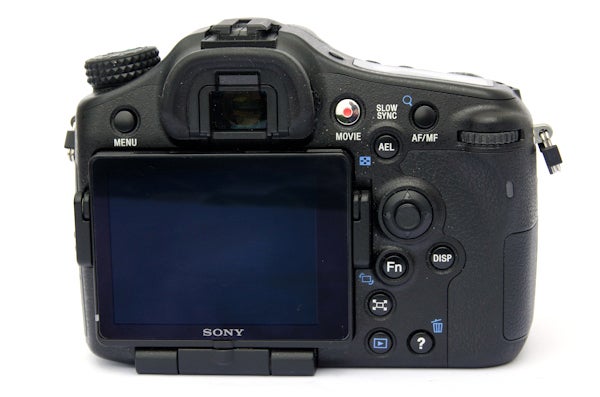
The A77 uses Sony’s own optimised BIONZ image processor, which has been optimised for speedy processing and low-noise images. Sensitivity ranges from a standard ISO 100 to 1600, with an extended low setting of ISO 50 also available. Exposure modes include the regular quartet of Program, Aperture-priority, Shutter-priority and Manual (PASM) modes as seen on regular DSLRs. These are supplemented by a fully Automatic mode, an Auto mode automatic scene recognition mode, eight individual Scene modes, the aforementioned Panorama Sweep mode, and a 3D mode (3D screen required). In addition there are also three Memory Recall user-defined custom settings to call upon.
In addition to its stills abilities the A77 offers a generous selection of movie recording options, including the ability to record in the HDTV-friendly AVCHD format at 1080/50p (28M, PS), 1080/50i (24M, FX) and 1080/25p (24M, FX). Those looking to plug the A77 into their HDTV for direct playback of AVCHD will find a HDMI jack on the side of the camera, although if you want to play AVCHD files back on a computer you may need to use the bundled Picture Motion Browser software to convert the files (or install software such as VLC that supports .MTS file playback).
Those looking to record movies in a more computer-friendly format can record MP4 files at either 1440 x 1080 (12MP) or VGA quality. While serious video enthusiasts will undoubtedly know which AVCHD setting is right for them, we can’t but help think that the A77 would benefit from a simple ‘1920 x 1080 Full HD’ MP4 option too. While in video mode it’s possible to use all of the PASM settings, which adds plenty of creative flexibility. Sound is recorded in stereo by default via a multi-directional microphone just in front of the hotshoe and in addition there’s also a jack to plug external microphones into. 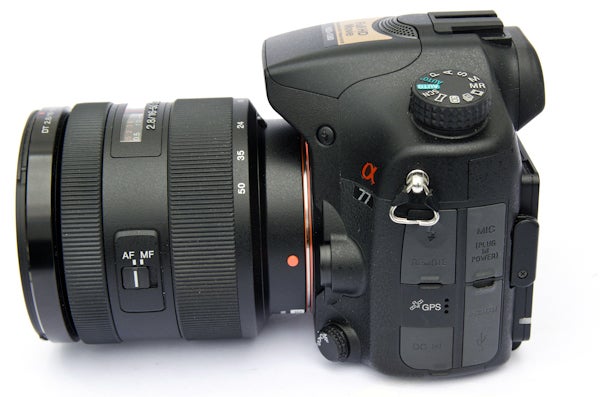
On the back of the A77 is a 3in, 921k-dot LCD monitor with Sony’s TruBlack technology. The screen offers a sharp and detailed image with plenty of colour and contrast although it is prone to fingerprint smudges, which necessitates regular cleaning. The screen itself is attached to the camera via two hinges, which allows it to be pulled right out from the body and liberally adjusted on the vertical axis to make light work of shooting overhead or from the hip. In addition the screen also rotates on the bottom hinge, which allows you to shoot at odd angles, around corners or even with the monitor facing the same direction as the lens for self-portraits. Last but not least you can also fold the screen back into the camera to protect it.
Of course, with this being an SLT camera there’s no optical viewfinder. Instead the A77 employs an electronic viewfinder (EVF) that covers 100% of the scene with a resolution of 2.36m-dots. This is currently the highest resolution of any EVF on any camera and makes shooting with the A77 at eye-level a relatively painless experience with the EVF offering plenty of detail, rich colours and good levels of contrast. It’s not quite perfect though and we did find that in bright sunlight the A77’s EVF is still no match for a traditional optical viewfinder, even with the brightness turned right up. Also, in dark conditions you can expect noise to interfere with the overall quality of the EVF image too. In just about every other situation between these two extremes though there is very little to complain about.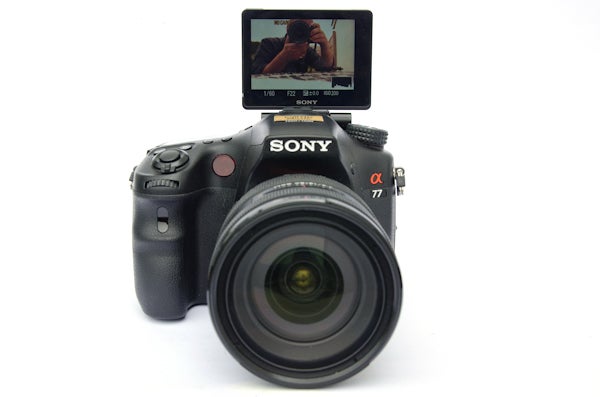
Given that the A77 is targeted primarily at the advanced enthusiast and prosumer market, it’s no surprise to find that overall build quality is very high. The guts of the camera are housed within a magnesium alloy cage, with the outer shell constructed from a toughened plastic finished with a classy mottled effect. While we appreciate that ‘toughened plastic’ might not sound all that impressive on paper in the hand the A77 really does feel quite solid, with a reassuring weightiness to it. Seals around key buttons and dials guard against moisture and dust penetration too, giving the A77 some added all-weather appeal. Those looking for a robust workhorse are unlikely to be disappointed.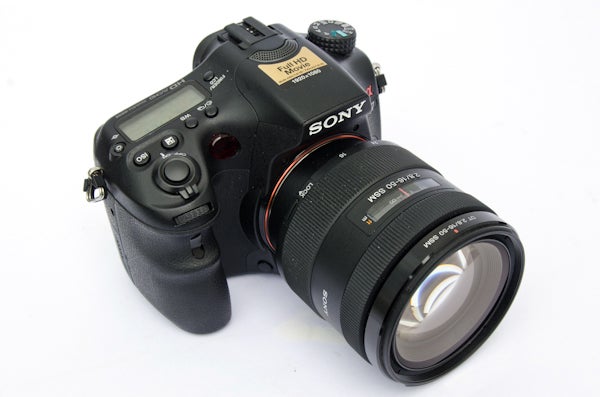
The A77 sits quite comfortably in the hand thanks primarily to the ergonomic handgrip. This has a channel cut into it that allows the middle finger to sit more comfortably, while promoting a more secure grip. In addition, the there’s also a raised ridge on the back of the camera just below the thumb wheel, which gives you something to brace your thumb against. Both the finger grip and thumb rest are coated in a tactile rubber that further aids grip. Together they make the A77 a very comfortable camera to hold, although the grip is fairly deep and those with small hands may find it harder to wrap their fingers fully around it. Given the camera weighs around 800g body-only or 1.4kg with a Sony DT 16-50mm f/2.8 lens this is quite an important consideration.
As an advanced camera the A77 sports a fairly large collection of physical buttons and dials, evenly distributed along the top and back of the camera. These allow advanced shooters to quickly access regularly used camera settings like ISO and EV Compensation without having to enter the main in-camera menu. In addition, the Fn button on the back can be used to call up a quick menu that presents you with a good selection of all the main shooting options including access to AF Area, Face Detection settings, Creative Styles and Picture Effects.
Menu navigation is controlled via a small thumb-stick within easy reach of the thumb, which also acts as the ‘select’ button when pressed. The main in-camera menu is all fairly straightforward enough, although we did find that it can be frustratingly easy to make the wrong selection on account of the thumb-stick not offering much in the way of resistance, making it all too easy to inadvertently press while navigating. 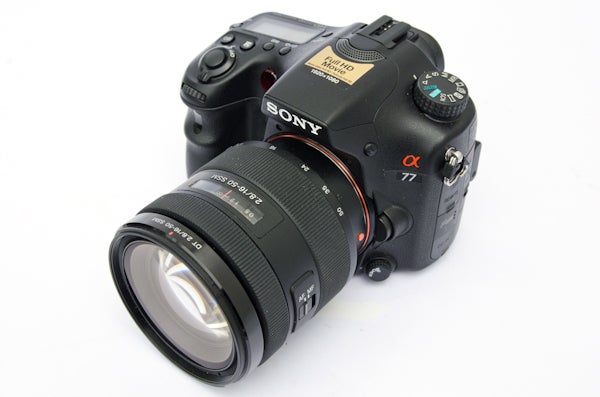
There are also two main control wheels, one on the front and one of the back, which makes quicker work of controlling the camera – especially when it’s being used in Manual mode. The A77 also sports a useful LCD display on the right-hand shoulder just behind the shutter release button displays all of the important shooting information and can be illuminated for use in darker conditions via a bulb button just to the right of it.
In terms of general performance the A77 scores very highly. Start-up isn’t quite as instant as a regular DSLR with the A77 taking a fraction under two seconds from the initial flick of the power switch before it’s focused and ready to shoot. This aside, the camera remains impressively speedy in all other areas, with the 19-point (11 cross-type) phase detection autofocus especially quick to lock on, even in less than optimal light. AF points are collected together in a three distinct blocks or ‘zones’, offering relatively good horizontal coverage across the centre of the viewfinder. Autofocus options extend to multi-point AF, single zone (with the user able to select from the left, right or central blocks/zones), centre Spot AF, and a user-controlled Spot AF option that allows you to fix focus using any one of the 19 individual AF points.
Processing speeds are pretty quick with the A77 able to shoot seven full-res JPEG or Raw files within a ten-second period in Single-shot drive mode, and with no upper limit on the number of consecutive shots you can take. Used in one of the Continuous drive modes the number of consecutive shots you’ll be able to take will vary according to the quality setting you’re using. In the 12fps Continuous Advance Priority drive mode (accessed directly via the exposure mode wheel) you can expect to fire off around 14 extra fine JPEGs in a fraction over a second before the memory buffer fills and shooting speed drops closer to 1fps. Shooting in Raw, this drops to 12 consecutive frames, after which the camera slows to 0.5fps.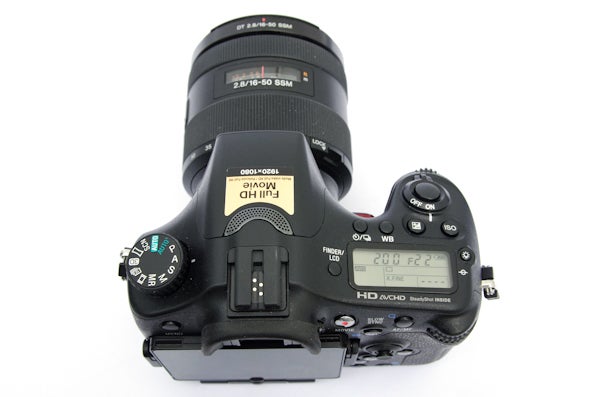
In addition to the super-fast Continuous Advance Priority mode, the A77 also offers a regular 8fps ‘High’ continuous drive mode along with a ‘Low’ option that shoots at closer to 4fps. With both options, overall performance remains almost identical to the Continuous Advance Priority mode: with the camera set to ‘High’ you can expect to capture around 14 full-res extra fine quality JPEGs in a fraction under 2secs, after which the camera slows to around 0.8fps. With the camera set to record Raw, expect this to drop to 12 images inside 1.8secs, after which the speed will tail off to one frame every two seconds. Either way, the A77 remains impressively fast, making it an ideal choice for those who regularly shoot fast-moving action.
Image quality is generally very impressive. The A77’s 24.3MP sensor is able to resolve plenty of fine detail and produce images that can be safely enlarged without compromising quality. Of course, the extra resolution does come at the expense of large file sizes and you can expect a typical fine-quality full-res JPEG to measure around 14-18MB in size, with Raw files closer to 25MB.
The A77 is well served by the optional DT 16-50mm f/2.8 ‘kit’ zoom that can be supplied with it. Not only is it fairly quick at f/2.8, it also offers good levels of sharpness across the whole frame (especially at f/7.1-f/8) and is capable of producing gorgeous bokeh when opened right up. The A77 offers a number of useful in-camera lens correction options should you require them, including fixes for vignetting, chromatic aberrations and lens distortion. They all work pretty well, although we suspect many Raw shooters will prefer to make their own corrections using Photoshop.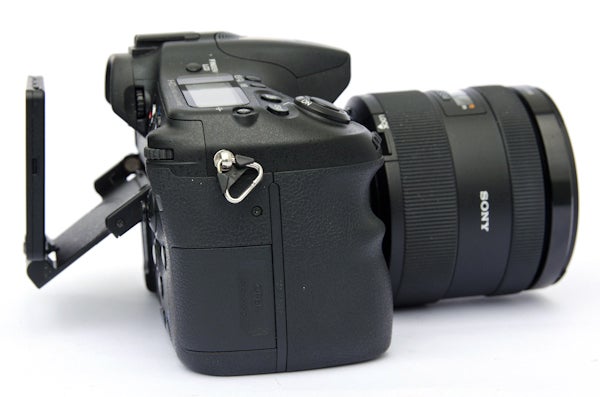
There are six Picture Style options in total: Standard, Vivid, Neutral, Portrait, Landscape and Black and White. It’s also possible to fine-tune the contrast, saturation and sharpness levels for each Picture Style so as to get them just as you like. Irrespective of which Picture Style you opt for we found that the Automatic and Auto settings tend to produce JPEGs with noticeably more saturation and contrast than any of the PASM modes, so if you’re looking for something more neutral the PASM modes are usually a better option.
Although the A77’s 1200-zone metering module generally performs very well we did notice a tendency for it to slightly underexpose images on the odd occasion, although this can easily be rectified with the /-5EV of exposure compensation on offer. The A77 is able to capture a good dynamic range even with the Dynamic Range Optimiser function switched off. It has to be said that this tool does come in handy when you want to boost highlight and shadow retention without going the whole HDR hog – just so long as you are shooting JPEGs, that is. Those with a penchant for HDR photography will find that the Automatic HDR option produces very good results although the use of a tripod is advisable.
Noise is especially well controlled at lower sensitivity settings of ISO 100-400, although by ISO 800 it is possible to see the softening effects of the A77’s built-in noise reduction, but only if you go looking for it by enlarging the image to 100% or more. While noise does begin to creep into the image more noticeably after ISO 1600 and ISO 3200 it’s still not really an issue unless you are specifically looking for it and both settings can be used to make perfectly acceptable images with. By ISO 6400, however, noise becomes distinctly visible at all image sizes, while the top two settings of 12,800 and 16,000 offer fairly poor image quality and should only really be treated as a last resort.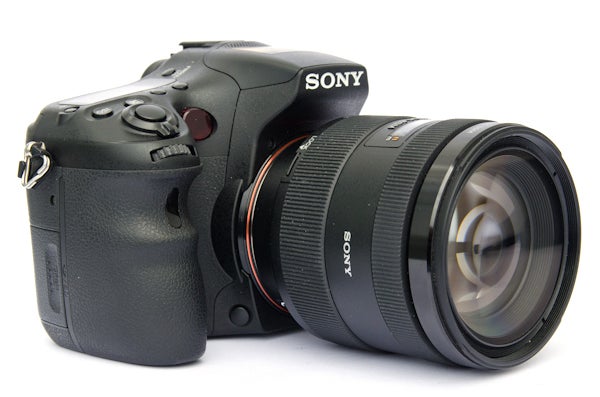
Verdict
The Sony Alpha A77 is an excellent addition to Sony’s single lens translucent range. As the flagship model within the range it’s extremely well specified and flexible camera with a generous range of features that will appeal to serious photography enthusiasts. While it’s 12fps continuous shooting speed will certainly appeal to those who regularly shoot fast-moving action, there’s a lot more to like about the A77, not least the speedy AF performance, excellent range of movie recording options and high standard of image quality.

At ISO 100 images are clean and sharp and free of noise.

ISO 200 is virtually identical to ISO 100.

At ISO 400 and the A77 is still producing clean, noise-free images.

ISO 800 shows the merest hint of softening, but you really have to go looking for it.

By ISO 1600 there is some noise, and some softening, although it’s still very usable.

At ISO 3200 noise is more pronounced.

ISO 6400 is the cut-off point in terms of overall image quality.

At ISO 12,800 noise is clearly visible even at reduced image sizes.

ISO 16,000 is really for emergency use only.
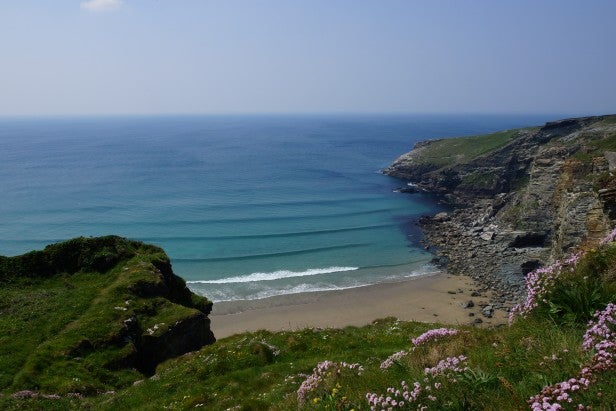
Shooting JPEGs on either Automatic or Auto (as above) produces images with plenty of saturation and contrast.

Whereas images shot in any of the PASM modes with the Picture Control set to standard, produces something more neutral.

The A77’s Dynamic Range Optimiser has done a good job of preserving detail in the subject’s face in this back-lit portrait.

The Sony DT 16-50mm f/2.8 can be used to create lush bokeh in defocused areas.

Using the ‘Vivid’ Picture Style produces images with punchy colour and tone.

Sony’s iSweep Panorama technology is the best there is for creating one-touch ultra-wideangle images.
Trusted Score
Score in detail
-
Value 8
-
Design & Features 9
-
Image Quality 9
-
Build Quality 9

